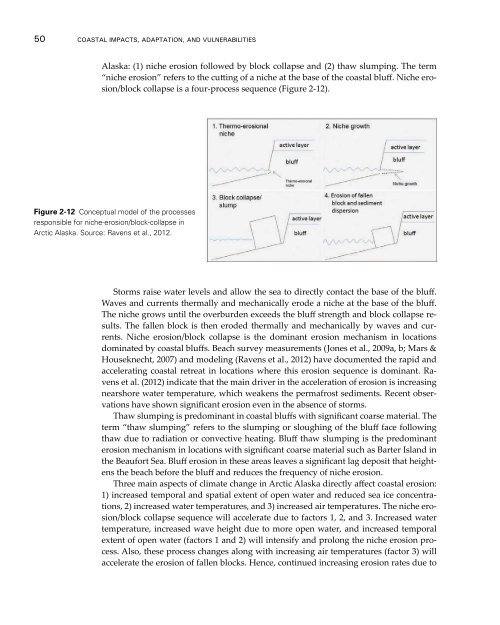Coastal Impacts, Adaptation, and Vulnerabilities - Climate ...
Coastal Impacts, Adaptation, and Vulnerabilities - Climate ...
Coastal Impacts, Adaptation, and Vulnerabilities - Climate ...
Create successful ePaper yourself
Turn your PDF publications into a flip-book with our unique Google optimized e-Paper software.
50 <strong>Coastal</strong> <strong>Impacts</strong>, <strong>Adaptation</strong>, <strong>and</strong> <strong>Vulnerabilities</strong>Alaska: (1) niche erosion followed by block collapse <strong>and</strong> (2) thaw slumping. The term“niche erosion” refers to the cutting of a niche at the base of the coastal bluff. Niche erosion/blockcollapse is a four-process sequence (Figure 2-12).Figure 2-12 Conceptual model of the processesresponsible for niche-erosion/block-collapse inArctic Alaska. Source: Ravens et al., 2012.Storms raise water levels <strong>and</strong> allow the sea to directly contact the base of the bluff.Waves <strong>and</strong> currents thermally <strong>and</strong> mechanically erode a niche at the base of the bluff.The niche grows until the overburden exceeds the bluff strength <strong>and</strong> block collapse results.The fallen block is then eroded thermally <strong>and</strong> mechanically by waves <strong>and</strong> currents.Niche erosion/block collapse is the dominant erosion mechanism in locationsdominated by coastal bluffs. Beach survey measurements (Jones et al., 2009a, b; Mars &Houseknecht, 2007) <strong>and</strong> modeling (Ravens et al., 2012) have documented the rapid <strong>and</strong>accelerating coastal retreat in locations where this erosion sequence is dominant. Ravenset al. (2012) indicate that the main driver in the acceleration of erosion is increasingnearshore water temperature, which weakens the permafrost sediments. Recent observationshave shown significant erosion even in the absence of storms.Thaw slumping is predominant in coastal bluffs with significant coarse material. Theterm “thaw slumping” refers to the slumping or sloughing of the bluff face followingthaw due to radiation or convective heating. Bluff thaw slumping is the predominanterosion mechanism in locations with significant coarse material such as Barter Isl<strong>and</strong> inthe Beaufort Sea. Bluff erosion in these areas leaves a significant lag deposit that heightensthe beach before the bluff <strong>and</strong> reduces the frequency of niche erosion.Three main aspects of climate change in Arctic Alaska directly affect coastal erosion:1) increased temporal <strong>and</strong> spatial extent of open water <strong>and</strong> reduced sea ice concentrations,2) increased water temperatures, <strong>and</strong> 3) increased air temperatures. The niche erosion/blockcollapse sequence will accelerate due to factors 1, 2, <strong>and</strong> 3. Increased watertemperature, increased wave height due to more open water, <strong>and</strong> increased temporalextent of open water (factors 1 <strong>and</strong> 2) will intensify <strong>and</strong> prolong the niche erosion process.Also, these process changes along with increasing air temperatures (factor 3) willaccelerate the erosion of fallen blocks. Hence, continued increasing erosion rates due to
















